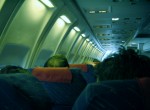The company was founded on the 24th September, 1947 with an authorized capital of CYŁ250.000. Its main shareholders were British European Airways (44.90%), the Cyprus Government (22.45%), and local shareholders (32.65%).
The following year the Company acquired 3 Dakota and started operating from the airport that had been established in Nicosia and provided services to Middle East and Europe.
Three years later the fleet increased to 6 Dakotas, and new services were inaugurated. With the introduction of the Comet 4B on all routes to the Middle East on April 1st, 1960, Cyprus Airways was the only airline in the area operating purely with jet engine aircraft.
By the early 1970s Cyprus Airways established itself as a full international carrier with its own tour operating company, Cyprair Tours Limited. Two modern Trident aircraft were added to the fleet and two more were ordered. New services were added to the network and booking offices were opened both locally and abroad as well as representation abroad. The Turkish invasion in July of 1974 put a tragic end to the successful operations of the Company and cancelled all plans for the future. Suddenly Cyprus Airways found itself without aircraft: one of the Trident IE`s was completely destroyed, while the other four remained enclaved at Nicosia International Airport, which was under the control of the United Nations.
February 1975 saw the restart of operations from the small Larnaca Airport, with two 73-seater Viscount aircraft leased from British Midland Airways. The first services were operated to Beirut, Tel-Aviv and Athens via Heraklion. There were no direct flights to London but passengers were carried to Athens by Cyprus Airways, and Athens-London by British Airways. Thus air communications between the island and the rest of the world were restored. By the end of that summer the Cyprus Airways fleet had increased to four Viscounts, and both passenger and cargo flights to these three destinations had increased considerably.
At the beginning of 1979 Cyprus Airways received the two Boeing 707s which had been ordered the previous year and in April 1979 the fleet was enlarged with the arrival of a third Boeing 707S. Since that time the Company had owned all its aircraft. In September 1980 the Company`s Chairman, Mr. George Eliades, died after 20 years of continuous service with Cyprus Airways.
The Cyprus Government, major shareholder of the airline, appointed Mr. Stavros Galatariotis as the new Chairman in January 1981, and a new Board of Directors was formed in February which embarked on a campaign for the reorganisation and reconstruction of the airline. Its General Manager, Mr. E.Savva, resigned in July of the same year.
In November 1981 British Airways, one of the Company`s then major shareholders, agreed to sell most of its shares to the Cyprus Government, and retained a small shareholding of 5%. The Government`s shareholding had now increased to 70.86%, while individual shareholders continued to hold 24.14%.
In 1981 the airline put an order for two Airbus 310 aircraft for delivery in 1984, following the lead of other carriers in the area to replace their fleet with wide bodied, comfortable aircraft, which would also prove more economical to operate.
In November 1983 Paphos International Airport was opened, and Cyprus Airways began operating a number of special flights to this alternative airport.
1984 marked the beginning of a new era for Cyprus Airways. The delivery of its first two Airbus 310s provided the airline with wide-bodied aircraft and it was the beginning of a new fleet equipped with the most technically advanced aircraft in the aviation world.
The same year the company ordered four Airbus A320 aircraft powered by IAE V2500 engines for delivery in early 1989, with an option for an additional aircraft for later delivery. In so doing Cyprus Airways became one of the five launching airlines of the A320 programme.
Along with its new, modern aircraft, and completely new livery, the company also introduced a special new service for regular business passengers with the formation of the Sunjet Executive Club. Extra benefits and privileges offered to these customers included use of the Sunjet Executive Lounge that was opened at Larnaca the same year.
In 1986 Cyprus Airways` destinations increased to 28 as the island was linked with another seven new destinations. In 1987 the company decided to exercise its option on four additional A320 aircraft for delivery in 1991 and 1992, and also to order a fourth Airbus 310 aircraft, for delivery early in 1989.
In March 1989 the appointment of Mr. Kikis Lazarides as the new chairman of Cyprus Airways was announced. In the face of growing competition, which would only increase as liberalisation of European air services grew closer, the company commissioned an independent survey of its operations by international consultants.
A new Chief Executive Officer was appointed in January 1990. During this year the company`s main objective was to render Cyprus Airways more market orientated and customer driven; increase market share, improvement in yield and increased productivity and aircraft utilisation.
Meanwhile, turning to productivity and cost, the company introduced a redundancy compensation scheme to reduce its payroll and overall staff levels.
During 1990 the company went ahead with the setting up of a local distribution network. Other plans ranged from the complete redesign of all aircraft interiors and livery to new uniforms, changes in graphics and signage, upgrading of galleys and stowage on the Airbuses, new menus and improved food and beverage equipment. The company also finalised planning its upgraded business class product which would provide high yield passengers with comfort, service and facilities of an international standard.
In 1991 a number of new destinations were added to the company`s network, and the company also entered an agreement with KLM whereby Cyprus Airways would undertake joint flights on its A320`s, in cooperation with the Dutch airline, between Amsterdam, Larnaca, Amman and Damascus. The agreement followed its policy of seeking strategic alliances with major airlines, and demonstrated that Cyprus Airways` operations were perceived to be of a standard comparable with leading European airlines.
The decision having been taken to form a separate charter airline, Eurocypia Airline, the new company was registered in Cyprus with the object of operating with the participation of major tour operators. The new charter company would compete in price and quality with the most efficient European charter operators. It would operate A320`s leased from Cyprus Airways with high density configuration.
In June 1991 Cyprus Airways launched its new corporate image, revealing its redesigned livery in colours of blue, ochre and white, with interiors echoing nineties trends and staff attired in updated uniforms.
In 1992 the frequent flyers programme was launched. A reward scheme for Cyprus Airways most loyal passengers. When a traveler flies on Cyprus Airways flights, he/she earns points which can be exchanged for flight or service awards.
In May 1993 followed the resignation of Mr Kikis Lazarides, Mr Vassilis Rologis took over as Chairman of Cyprus Airways.
In July 1995 the three BAC1-11 aircraft were sold to the South African airline Nationwide Air Charter (Pty) Ltd, through the process of international tender. So, as of 1995 Cyprus Airways became an all Airbus operator, with eight Airbus A320s and four A310s. Three of the eight Airbus A320s were in service with Eurocypria under a lease agreement.
End of 1996 Mr Vassilis Rologis resigned from his post as Chairman of Cyprus Airways and in January 1997 Mr Takis Kyriakides was appointed as the new Chairman.
In September 1997 Cyprus Airways proudly celebrated its 50th anniversary. The current decade had presented the company with the most serious and far-reaching challenge since 1974. With the twin threats of intense competition and deregulation of the skies, the airline has effected vital changes in its bid to reposition itself within a fast-changing industry. During the years of the nineties Cyprus Airways has concentrated on improving customer service, reducing costs and aggressive marketing – a strategy designed to channel the airline through the uncharted skies of the future.
On the 30th of November 1999, Mr Haris Loizides had been appointed as the new Chairman of Cyprus Airways.
In a statement released shortly after his appointment, Mr Loizides, said that as a member of the Board of Directors of Cyprus Airways for many years, he was fully aware of the difficulties involved in the task he had undertaken.
Among his priorities is the consolidation of harmonious labour relations and the maintenance of continuous and long-term industrial peace. He considers this as an indispensable pre-requisite for the survival and future growth of Cyprus Airways; one that has a direct impact on the best interests of the Company, its staff, the island`s tourist industry and the Cyprus economy. He finally conveyed a message of optimism for the future of Cyprus Airways and stressed that with close co-operation between the Board, the Management and the staff, based on mutual consensus, collective action and hard work by all concerned, all challenges should be overcome and a new chapter in the history of the Company would be opened. Information obtained from Cyprus Airways. For more information, please contact the airline or surf to their website at the Homepage address below.

|
|
|
![]()





